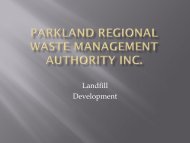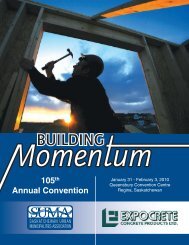Long-term Debt Limits in Saskatchewan - Nipawin
Long-term Debt Limits in Saskatchewan - Nipawin
Long-term Debt Limits in Saskatchewan - Nipawin
Create successful ePaper yourself
Turn your PDF publications into a flip-book with our unique Google optimized e-Paper software.
of debt, while permitt<strong>in</strong>g the prov<strong>in</strong>ce the flexibility<br />
to <strong>in</strong>crease debt where feasible. If this is too ad hoc for<br />
municipalities, then a more precise policy needs to be<br />
developed so that municipalities can plan.<br />
C. Request that the Prov<strong>in</strong>ce Consider Remov<strong>in</strong>g Utilities<br />
<strong>Debt</strong> from Calculation: As mentioned above, Nova Scotia<br />
does not <strong>in</strong>clude water and electrical utilities debt <strong>in</strong> debtlimit<br />
calculations. <strong>Debt</strong> for these utilities is still regulated by<br />
prov<strong>in</strong>ce. <strong>Saskatchewan</strong> could do the same, and cont<strong>in</strong>ue<br />
to regulate municipal debt through the SMB, which would<br />
ensure oversight ma<strong>in</strong>ta<strong>in</strong>ed. However, this may, <strong>in</strong> some<br />
cases, provide greater flexibility to municipalities.<br />
D. Advocate for a Prov<strong>in</strong>ce-wide Solution to Infrastructure<br />
Needs: Many municipalities mentioned that they need to<br />
make major upgrades to water and sewer system, as per<br />
new federal regulations. Many of these municipalities cannot<br />
afford to make these upgrades without <strong>in</strong>creas<strong>in</strong>g their debt<br />
load, but cannot feasibly service debt at the levels needed to<br />
meet the new requirements . Thus, it appears that there is<br />
a need for a strategy to assist municipalities with develop<strong>in</strong>g<br />
susta<strong>in</strong>able <strong>in</strong>frastructure.<br />
Policy Problem 2:<br />
A number of municipalities are fac<strong>in</strong>g <strong>in</strong>frastructure<br />
challenges, and cannot afford to replace necessary utilities<br />
<strong>in</strong>frastructure such as water and sewer.<br />
Analysis:<br />
Our comparative research on Alberta’s RSC models,<br />
as well as our discussions with municipal officials <strong>in</strong><br />
<strong>Saskatchewan</strong> highlighted the option of regionalized service<br />
delivery, which may make replac<strong>in</strong>g <strong>in</strong>frastructure feasible<br />
for some municipalities. This is especially true for smaller<br />
municipalities <strong>in</strong> rural areas where it may not be possible for<br />
one municipality to build its own water treatment plant, but<br />
where collaboration on a regional scale might be achievable.<br />
It may also be easier for municipalities to access grant<br />
fund<strong>in</strong>g to build regional <strong>in</strong>frastructure, as was the case<br />
with the Sask Land<strong>in</strong>g Regional Water Pipel<strong>in</strong>e Utility.<br />
To summarize, the two options we exam<strong>in</strong>ed are:<br />
1. RSCs: As mentioned, municipalities <strong>in</strong> Alberta engage <strong>in</strong><br />
RSCs to deliver services on a regional basis. This is potentially<br />
beneficial because it removes some utilities-based debt from<br />
the municipality to the RSC, creates efficiencies <strong>in</strong> service<br />
deliver, reduces costs, and allows some municipalities to<br />
access grants for service delivery through RSCs. With RSCs the<br />
municipality frees up adm<strong>in</strong>istrative capacity for other activities.<br />
2. Regional Service Delivery <strong>in</strong> <strong>Saskatchewan</strong>: One<br />
group of municipalities has regionalized the delivery of water<br />
purification and transportation. The Sask Land<strong>in</strong>g Regional<br />
Water Pipel<strong>in</strong>e Utility, which was created by a group of towns<br />
and RMs <strong>in</strong>clud<strong>in</strong>g the Towns of Kyle and Elrose, will treat and<br />
deliver potable water to the Towns of Kyle and Elrose,<br />
as well as to the residents of the surround<strong>in</strong>g RMs, and some<br />
major customers such as nearby Hutterite colonies and large<br />
farm operations (Infrastructure Canada). The Sask Land<strong>in</strong>g<br />
Regional Water Pipel<strong>in</strong>e Utility was set up because water<br />
quality was poor, and it was a solution that was recommended<br />
by SaskWater. The municipalities were able to develop this<br />
because of grant fund<strong>in</strong>g available from the federal and<br />
prov<strong>in</strong>cial governments, and fund<strong>in</strong>g costs worked out to<br />
roughly 1/3 municipal, 1/3 prov<strong>in</strong>cial, and 1/3 federal dollars.<br />
In the long run, because the utility is separate from the<br />
municipality, and because the costs are recovered on a fee for<br />
service basis, this should shift utilities related debt away from<br />
the municipalities, free<strong>in</strong>g debt capacity for other needs. One<br />
municipal partner suggested that this type of <strong>in</strong>itiative, while it<br />
is <strong>in</strong>novative and has proved successful, would not have been<br />
possible without grant fund<strong>in</strong>g. Moreover, the will<strong>in</strong>gness<br />
to work together with neighbours and create a third party<br />
organization was imperative to the success of this <strong>in</strong>itiative,<br />
which is now shovel ready with pipes be<strong>in</strong>g laid <strong>in</strong> some areas.<br />
Recommendations:<br />
The above two examples are options for <strong>Saskatchewan</strong><br />
municipalities to consider <strong>in</strong> address<strong>in</strong>g <strong>in</strong>frastructure<br />
challenges, especially water and sewer, which appear to<br />
be significant challenges <strong>in</strong> <strong>Saskatchewan</strong>.<br />
In order to address the above concerns, SUMA should<br />
consider the follow<strong>in</strong>g actions:<br />
A. Survey Members About Regional Service Delivery:<br />
Survey members about their <strong>in</strong>terest <strong>in</strong> engag<strong>in</strong>g <strong>in</strong> regional<br />
service delivery arrangements. De<strong>term</strong><strong>in</strong>e the level of <strong>in</strong>terest,<br />
as well as the perspective of members on how such<br />
an arrangement ought to be designed.<br />
B. Communicate with Municipal Partners: If there is<br />
an appetite among members, SARM should be approached<br />
to de<strong>term</strong><strong>in</strong>e if their members have an <strong>in</strong>terest <strong>in</strong> this.<br />
C. Approach Prov<strong>in</strong>ce about Fund<strong>in</strong>g: If there is<br />
an appetite for this, approach the prov<strong>in</strong>ce and federal<br />
government about targeted fund<strong>in</strong>g for sett<strong>in</strong>g up and<br />
implement<strong>in</strong>g regional service delivery groups. It is clear<br />
from our research that regional service delivery arrangements<br />
require fund<strong>in</strong>g to be developed.<br />
Process Problem 3:<br />
A number of municipalities mentioned that the processes<br />
of the SMB could be improved and streaml<strong>in</strong>ed to better<br />
serve municipalities.<br />
Analysis:<br />
The municipalities we <strong>in</strong>terviewed mentioned that<br />
streaml<strong>in</strong><strong>in</strong>g and simplify<strong>in</strong>g the application process would<br />
improve efficiency. This was also reflected <strong>in</strong> the survey data.<br />
Municipalities suggested that the SMB could be improved <strong>in</strong><br />
the follow<strong>in</strong>g areas:<br />
15






